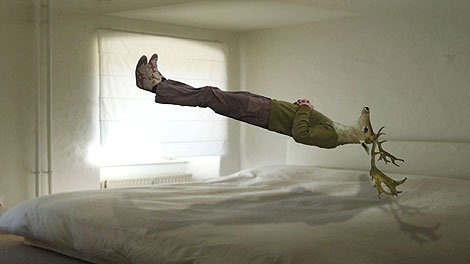Two exhibitions
dal 3/2/2008 al 28/3/2008
Segnalato da
Ileana Tounta Contemporary Art Centre
3/2/2008
Two exhibitions
Ileana Tounta Contemporary Art Centre, Athens
Dimitris Tsoumplekas: in his photographs, videos and installations, he employs the language of fable and fairy tale to narrate allegorical tales of family life. Dimitris Baboulis presents drawings created with India ink on rice paper and wood, as well as two installations/sculptures in fiberglass.

In Family Affairs, Dimitris Tsoumplekas revisits the sites and landscapes of childhood and contemplates them through the eyes of the adult. In his photographs, videos and installations, the artist employs the language of fable and fairy tale to narrate allegorical tales of family life. Animals, incidents of transformation, secret dens in the woods, steaming pots: these are some of the symbols that allow him to comment on family legends and family trees, but also to offer some fundamentally autobiographical thoughts on the contemporary family – this small, idealized yet, in essence, rather menacing nucleus that is the architect of passions.
Continuing his investigations into the notion of space and the impact of architecture on our personal histories (enduring concerns of the artist that have mainly been expressed in solo exhibitions such as “Open Kitchen-Broken Homes” and “Satori in Maroussi”), Dimitris Tsoumplekas ultimately arrives at a sort of existential architecture that suggests we are not simply the residents of homes and neighbourhoods and cities, but more so the residents of our inner worlds. The idiosyncratic architecture of these internal landscapes recalls the faith placed in fairy tales by the Brothers Grimm; a faith in “those secret hideaways to be found in homes and backyards, passed down from grandfather to grandson, that now seem to be constantly making way to accommodate the need for more usable space in our new homes – the need for a kind of empty and foolish grandeur”.
As far as utility is concerned, the artist reserves his own definitions of a notion that has summarily been determined by advertising, the laws governing consumption and a set of so-called “imperative” needs: by combining the reality of family life (its frustrations, the violence of coming of age, the utopia of childhood) and fairy tale iconography (forests and towers, nightmarish Little-Red-Riding-Hoods and precocious children climbing upon a cloud), he reinvents utility as a lyrical, perhaps even futile luxury, which can however help name the world, and our place within it, anew.
............................
In his first solo exhibition, that is to be held on the gallery’s ground floor, Dimitris Baboulis will present drawings created with India ink on rice paper and wood, as well as two installations/sculptures in fiberglass.
The artist’s works are narrative in character and each story he tells demonstrates a keen attention to detail. Baboulis uses a rapidograph to “embroider” the surface of the rice paper with anthropomorphic motifs, consistently juxtaposing figures of skeletons and humans and filling their surrounding space with architectural patterns. His method renders his drawings clear and precise, thus allowing him to achieve that delicate balance between organic reality and the realm of fantasy. Colour is usually absent from his work. The predominance of white in these works, a symbol of light and purity, is a conscious choice on the part of the artist. The quality of purity, which is in fact a contemporary allusion to the concept of catharsis, is a key element of his work.
One of the installations on show depicts a male figure sitting at a loom and weaving a carpet out of the entrails of a reclining female figure. In this cyber version of the story of Frankenstein, the artist seems to be suggesting that the soul of the female figure (which one may clearly make out in the accompanying drawing) is being freed from the torment she suffers. The amorphous, buoyant fiberglass sculpture, which the artist calls a “soul tank”, becomes a repository for “cathartic elements”. The sense of a clear distinction between good and evil exuded by this work and the almost incorporeal and thus supremely gentle figures that inhabit it lend it a pronounced religious quality. Theme in his drawings –skeletons, a depiction of anatomy classes, the guillotine– fails to evoke feelings of horror and repulsion: though their subject may often be gruesome, these images nonetheless possess a subtle, poetic feel; a solitary, romantic air.
In Baboulis’ work introversion becomes a tool for dealing with the need for companionship; the need for clarity or purity, a word the artist himself has used to describe the way to go forth while remaining faithful to one’s own concerns and origins
text by: Eleni Garoufalia
Image: Dimitris Tsoumplekas
Ileana Tounta Contemporary Art Centre
48 Armatolon-Klephton st. - Athens
Free admission



